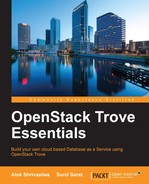In this book, you will find a number of text styles that distinguish between different kinds of information. Here are some examples of these styles and an explanation of their meaning.
Code words in text, database table names, folder names, filenames, file extensions, pathnames, dummy URLs, user input, and Twitter handles are shown as follows: "We should be able to find the screen name using the screen –ls command."
A block of code is set as follows:
FLOATING_RANGE=192.168.1.0/27 FIXED_RANGE=10.1.10.0/24 FIXED_NETWORK_SIZE=256 FLAT_INTERFACE=eth0 ADMIN_PASSWORD=adm1npwd DATABASE_PASSWORD=dbr00tpwd RABBIT_PASSWORD=rabb1tpwd SERVICE_PASSWORD=oss3rvice SERVICE_TOKEN=x1y1z1token
Any command-line input or output is written as follows:
export http_proxy=http://172.21.2.17:80 export https_proxy=http://172.21.2.17:80 export no_proxy=localhost,172.22.6.0/24
New terms and important words are shown in bold. Words that you see on the screen, for example, in menus or dialog boxes, appear in the text like this: "Once you are able to log in, navigate to System | System Information."
..................Content has been hidden....................
You can't read the all page of ebook, please click here login for view all page.
